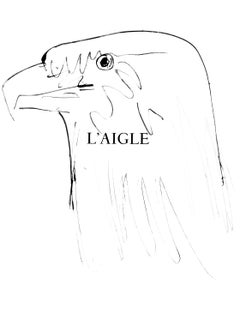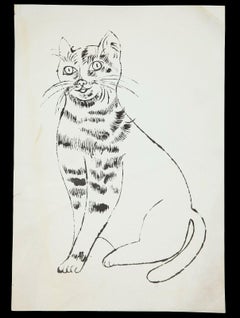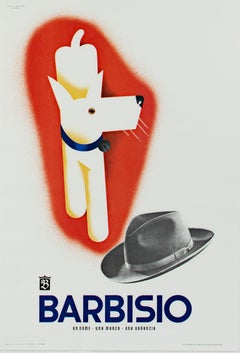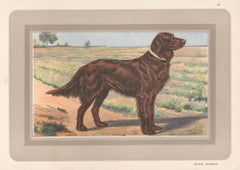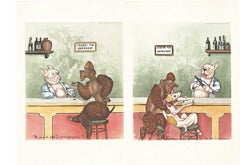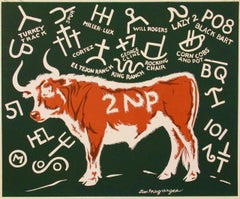Mid-20th Century Animal Prints
to
120
453
149
120
66
32
Overall Width
to
Overall Height
to
289
114
89
37
29
25
25
15
6
3
2
1
34
33
31
26
22
695
1,425
2,651
1,862
34
29
64
165
99
154
241
630
355
320
661
463
352
3
354
219
202
171
120
93
88
87
86
70
58
52
47
44
35
34
31
27
25
20
475
164
50
47
42
128
149
452
244
Period: Mid-20th Century
Picasso, L'aigle (Cramer 84; Johnson/Stein 77) (after)
Located in Southampton, NY
Collotype on vélin du Marais paper. Paper size: 14.5 x 11.125 inches. Inscription: Unsigned and unnumbered, as issued. Catalogue raisonné reference: Goeppert, Sebastian, et al. Pablo...
Category
Cubist Mid-20th Century Animal Prints
Materials
Lithograph
$956 Sale Price
20% Off
Sam (from the 25 Cats Name Sam and One Blue Pussy portfolio) Estate Stamp verso
By Andy Warhol
Located in Philadelphia, PA
Andy Warhol
Sam
1954
Original offset lithograph on paper
Estate stamped and authenticated. Accompanied by External Andy Warhol Foundation COA
Category
Pop Art Mid-20th Century Animal Prints
Materials
Lithograph
"Barbisio, Dog & Hat" offset lithograph poster by Giovanni Mingozzi
Located in Milwaukee, WI
"Barbisio (Dog & Hat)" is an offset color lithograph poster by Giovanni Mingozzi, this example coming from the original printing of the poster. It features a white dog surrounded by ...
Category
Modern Mid-20th Century Animal Prints
Materials
Offset
Irish Setter, French hound dog chromolithograph print, 1930s
By P. Mahler
Located in Melbourne, Victoria
French chromolithograph, published in 1931. Signed by artist in the plate. Printed title lower right of sheet. Plate number top right. From a French series of illustrations of sporti...
Category
Art Deco Mid-20th Century Animal Prints
Materials
Lithograph
Esperan que l'amour ne tue pas! and L'ALCOOL TUE LENTEMENT prints
Located in Spokane, WA
This is for the set of both (2) original Boris O'Klein prints, part of his series of the 'dirty dogs of Paris." Both are in very good condition,...
Category
Art Deco Mid-20th Century Animal Prints
Materials
Lithograph
$760 Sale Price
20% Off
2 Lazy 2 P
Located in Phoenix, AZ
2 Lazy 2P, ca. 1939
Lon Megargee
Serigraph
20 x 24 inches
Signed in screen
Original serigraph print by Lon Megargee 1883 - 1960
Featured in "Hot Irons" by Oren Arnold and John Hale, 1940
SHIPPING CHARGES INCLUDE SHIPPING, PACKAGING & INSURANCE
Lon Megargee created this serigraph from his commission with Oren Arnold and John Hale to do their dust jacket for the book, " Hot Irons", 1940. Arnold and Hale wanted to establish a reference work, an "authority", with a entertaining history about the evolution of the brand. Megargee created a painting of a steer that was branded with the script, 2 Lazy 2 P. Surrounding the steer is a random display of famous brands of ranches in the Southwest. It was well received and must have prompted Megargee to create the likeness as a print.
The brand is described in chapter thirteen, page 207-208 and says, " Ed Stram, who was Arizona state veterinarian for sixteen years, fire-branded his cattle with this peculiar crest. It isn't peculiar unless you have an equally peculiar sense of humor. At a glance it appears to be just another typically unimaginative brand, but it has been used to make many a thousand girls blush, and a few thousand bashful young men as well".
COLLIER GALLERY, FINE ART ESTATE OF LON MEGARGEE
Born and raised in Philadelphia, Pennsylvania, Lon Megargee, at age 13, ran away from his upper class home and went West in 1896 led by his zest for the wild and adventuresome life. There he established a reputation as a cowboy painter and illustrator with work most associated with Arizona Brewing Company ads featuring humorous aspects of cowboy life.
In his youth, he worked as a free-lance cowboy, exhibition roper, poker dealer, and bronco buster in Arizona, and then went east again to study art in Philadelphia at the Pennsylvania Academy of Fine Arts, and to New York at the Art Students League and Pratt Institute.
He returned to Arizona, living in Cave Creek, Salt River Canyon, Phoenix and the last years of his life near Sedona. His Phoenix home later became a popular hotel and dining place called the Hermosa Inn.
Megargee was a ranch owner and also did oil canvases of the places he loved and the cowboy life he admired. By 1910, he was among the earliest resident artists, and was probably the best known artist in Arizona. His name was first associated with a landscape series of 15 large murals for the Capitol Building, newly constructed just after Arizona became a state in 1912. Another one of his paintings, Elemental, was the first painting by an artist living in Arizona to be acquired for the Municipal Collection of Phoenix. These works were chosen from entries in the State Fair, where he continued to win prizes for figure and landscape painting.
From 1911 to 1953, he did numerous commission works for the Santa Fe Railroad, including a work titledNavajos Watching a Santa Fe Train. Between 1915 and 1930, he also painted in the Los Angeles area of California and had entries in the California State Fair. He died in Cottonwood, Arizona. After his death, theSaturday Evening Post had a double-page reproduction of his painting Cowboy's Dream.
Creator of the iconic logo for the Stetson Hat Company, " Last Drop From his Stetson", still in use today.
Fine Art Estate of Lon Megargee
We offer signed in print and original signature block prints. Custom, hand carved, signature frames, with archival standards and a speciality in hand dyed mats and french matting are provided for a beautiful and timeless presentation.
Megargee explored different mediums; printmaking captivated him in particular. The contrast of the black and white block print method captured perfectly his interpretation of a bold American West. The first print was produced around 1921 and culminated with the creation of “The Cowboy Builds a Loop” in 1933 with 28 images and poetry by his friend, Roy George. Megargee continued producing prints throughout the 1940s and early 50s.
At age 13, Lon Megargee came to Phoenix in 1896 following the death of his father in Philadelphia. For several years he resided with relatives while working at an uncle’s dairy farm and at odd jobs. He returned to Philadelphia in 1898 – 1899 in order to attend drawing classes at the Pennsylvania Academy of the Fine Arts. Back in Phoenix in 1899, he decided at the age of 16 to try to make his living as a cowboy. Lon moved to the cow country of Wickenburg where he was hired by Tex Singleton’s Bull Ranch. He later joined the Three Bar Ranch . . . and, after a few years, was offered a job by Billy Cook...
Category
American Modern Mid-20th Century Animal Prints
Materials
Screen
"Brahma vs. Leghorn, " Farm Scene Wood Engraving by Howard Thomas
Located in Milwaukee, WI
"Brahma vs. Leghorn" is an original wood engraving by Howard Thomas. In front of an understated farm house, Brahma and Leghorn face off, ready to battle. An unidentified plant sits on the center. Unsigned.
Image: 6" x 7.44"
Framed: 13.75" x 15.18
Thomas Howard (1899-1971) born a Quaker in Ohio, trained in the Midwest at Ohio State University and the Chicago Art Institute. He taught in the Art Department of the Milwaukee State Teachers College (now University of Wisconsin-Milwaukee) where he became good friends with Carl Holty, Edward Boerner, Robert von Neumann...
Category
American Modern Mid-20th Century Animal Prints
Materials
Woodcut
A La Queue (Join the Queue) Naughty Dogs of Paris by O'Klein
Located in Paonia, CO
A La Queue (Join the Queue) original etching from the series Naughty Dogs of Paris showing a line of five dogs of various breeds trailing a small Chihuahua on a leash who is t...
Category
Other Art Style Mid-20th Century Animal Prints
Materials
Etching
$440 Sale Price
20% Off
Carmen, The Bull's Horns - Original Etching (Cramer #52)
Located in Paris, IDF
Pablo PICASSO
Carmen, The Bull's Horns, 1949
Original burin engraving (Atelier Lacourière, Paris)
Unsigned
On Montval wove paper 33 x 26 cm (12.9 x 10.2 in)
REFERENCES :
- Catalog...
Category
Modern Mid-20th Century Animal Prints
Materials
Etching
"Mi Gato, " Rare Black & White Pattern Collagraph AP signed by Joseph Rozman
Located in Milwaukee, WI
"Mi Gato" is an original collagraph by Joseph Rozman. The artist signed, dated, and titled the artwork below the image. This artwork is the artist's proof. This artwork features an a...
Category
Pop Art Mid-20th Century Animal Prints
Materials
Black and White
Picasso, Sans titre, Verve: Revue Artistique et Littéraire (after)
Located in Southampton, NY
Héliogravure on vélin des Papeteries du Marais paper. Paper Size: 14 x 20.5 inches, with centerfold, as issued. Inscription: Unsigned and unnumbered, as issued. Notes: From the album...
Category
Cubist Mid-20th Century Animal Prints
Materials
Lithograph
$956 Sale Price
20% Off
Griffon A Poil Laineux, French hound dog chromolithograph print, 1931
By P. Mahler
Located in Melbourne, Victoria
French chromolithograph, published in 1931. Signed by artist in the plate. Printed title lower right of sheet. Plate number top right. From a French series of illustrations of sporti...
Category
Art Deco Mid-20th Century Animal Prints
Materials
Lithograph
Original Coppertone Italian sun tan cream, small format vintage poster
Located in Spokane, WA
The Original Coppertone Italian suntan lotion vintage poster is in small format. It is backed with archival linen and is in Grade A condition. It is ready to frame.
Step Back in Time, One Tan at a Time!
Elevate your space with a piece of pop culture history! This original Coppertone vintage...
Category
American Modern Mid-20th Century Animal Prints
Materials
Offset
Original Owl and Pussy Cat - Greek theater poster
Located in Spokane, WA
Original The Owl And The Pussycat, by Edward Lear with all text in Greek.
Linen backed and in very good condition. One tiny printing flaw under the foot of the cat.
Translation:...
Category
American Modern Mid-20th Century Animal Prints
Materials
Lithograph
Owl, American Realist Poster by Erwin Rambow
Located in Long Island City, NY
Erwin Rambow, American (1925 - 2013) - Owl, Medium: Poster, Image Size: 15 x 15 inches, Size: 19.5 x 15.5 in. (49.53 x 39.37 cm), Frame Size: 21.5 x 17.75 inches
Category
American Realist Mid-20th Century Animal Prints
Materials
Offset
English Water Spaniel, French hound dog chromolithograph print, 1931
By P. Mahler
Located in Melbourne, Victoria
French chromolithograph, published in 1931. Signed by artist in the plate. Printed title lower right of sheet. Plate number top right. From a French series of illustrations of sporti...
Category
Art Deco Mid-20th Century Animal Prints
Materials
Lithograph
Alexander Calder Circus Reproduction Lithograph After a Drawing
Located in Surfside, FL
(after) Alexander Calder
"Calder's Circus" offset lithograph on wove paper after drawings by the artist
Published by Art in America and Perls gallery in 1964 (from drawings done in t...
Category
American Modern Mid-20th Century Animal Prints
Materials
Lithograph
Magritte, Un Séduisant Navire d'eau de Mer (after)
Located in Southampton, NY
Lithograph in Colours on Vélin d'Arches paper. Edition: 350, plus proofs. Signed in the plate by the artist; hand signed in pencil by the printer, Fernand Mourlot. Good Condition; never framed or matted. Notes: From the suite, Les Enfants Trouvés de Magritte, 1968. Published by A.C. Mazo et Cie, Paris; printed by Fernand Mourlot, Paris, 1968. Les Enfants Trouvés de Magritte comprised twelve coloured lithographs, four of which, Ma Mère l'Oye, Pierreries, La Belle Captive...
Category
Surrealist Mid-20th Century Animal Prints
Materials
Lithograph
$3,996 Sale Price
20% Off
Pekingnese, Chow and Spaniel, Cecil Aldin 1930s puppy dog lithograph
Located in Melbourne, Victoria
'Pekingnese, Chow and Spaniel'
Cecil Aldin dog lithograph, 1935.
Cecil Aldin was a British artist and illustrator best known for his paintings and sketches of animals, sports, and ...
Category
English School Mid-20th Century Animal Prints
Materials
Lithograph
Holy Cats by Andy Warhol’s Mother.
Located in London, GB
First edition, 8vo (23 x 14.5 cm); 20 lithographs on various coloured wove papers, printed recto only, with ‘The Estate of Andy Warhol’ and ‘Andy Warhol Foundation for the Visual Arts’ stamps to lower pastedown, numbered in pencil ‘PM 21.0048’; original lithographed paper covered boards, very minor staining to cover otherwise a fine copy.
Stamped by ‘The Estate of Andy Warhol’ and ‘The Andy Warhol Foundation for the Visual Arts, Inc.’
Andy Warhol’s mother...
Category
Pop Art Mid-20th Century Animal Prints
Materials
Lithograph
"After The Race" c1951 MUNNINGS, Sir Alfred
Located in Bristol, CT
A "Homelovers" print
By permission of the Southampton Corporation, owners of the original painting
Published by Frost & Reed London
Art Sz: 20 1/4"H x 25 3/4"W
Frame Sz: 27 1/2"H x...
Category
Mid-20th Century Animal Prints
Materials
Lithograph
The Dove, Modern Lithograph by Emile Gilioli
Located in Long Island City, NY
An original hand-signed limited edition lithograph by famed sculptor Emile Gilioli. Edition of only 75. Émile Gilioli (b. Paris, 10 June 1911, d. Paris,...
Category
Modern Mid-20th Century Animal Prints
Materials
Lithograph
Original 1940 Washington & Oregon Pictorial Map vintage poster
Located in Spokane, WA
Map of historical landmarks, American Indian territories, rivers, mountains, dams, colleges, federal grazing districts, cities, agriculture, and other activities that were present in...
Category
American Realist Mid-20th Century Animal Prints
Materials
Offset
Chow and Pekinese (Pekingnese), Cecil Aldin 1930s puppy dog lithograph
Located in Melbourne, Victoria
'Chow and Pekinese' (Pekingnese)
Cecil Aldin dog lithograph, 1935.
Cecil Aldin was a British artist and illustrator best known for his paintings and sketches of animals, sports, an...
Category
English School Mid-20th Century Animal Prints
Materials
Lithograph
Derniers Messages, Cubist Lithograph by Georges Braque
Located in Long Island City, NY
Georges Braque, French (1882 - 1963) - Derniers Messages, Year: circa 1965, Medium: Lithograph, Image Size: 23.5 x 17 inches, Frame Size: 28 x 19.5 inches
Category
Cubist Mid-20th Century Animal Prints
Materials
Lithograph
Zebra and foal by Orovida Pissarro - Animal etching
Located in London, GB
Zebra and foal by Orovida Pissarro (1893-1968)
Etching
20 x 17.3 cm (7⁷/₈ x 6³/₄ inches)
Signed and dated lower right Orovida 1938
Titled lower middle and numbered 4/50 lower right
...
Category
Mid-20th Century Animal Prints
Materials
Etching
Wassily Kandinsky - Horse Knight - Original Etching
Located in Collonge Bellerive, Geneve, CH
Wassily Kandinsky - Horse Knight - Original Etching
32 x 24 cm
1966
From the art review XXe siècle, San Lazzaro
Unsigned and unumbered as issued
Category
Abstract Geometric Mid-20th Century Animal Prints
Materials
Etching
Siamese Cats by Orovida Pissarro - Animal etching
Located in London, GB
SOLD UNFRAMED
Siamese Cats by Orovida Pissarro (1893-1968)
Etching
10 x 7.5 cm (4 x 3 inches)
Artist biography
Orovida Camille Pissarro, Lucien and Esther Pissarro’s only child, wa...
Category
Mid-20th Century Animal Prints
Materials
Etching
$1,050 Sale Price
20% Off
Head of a Bull (Plate XXXII), from Carmen
Located in Washington, DC
Artist: Pablo Picasso
Title: Head of a Bull (Plate XXXII)
Portfolio: Carmen
Medium: Etching on Montval wove paper
Year: 1949
Edition: 289
Sheet Size: 13" x 10 3/16"
Signed: No (signe...
Category
Cubist Mid-20th Century Animal Prints
Materials
Etching
Cheval, Modern Etching and Aquatint by Andre Francois
Located in Long Island City, NY
Andre Francois, Hungarian (1915 - 2005) - Cheval, Year: circa 1960, Medium: Etching and Aquatint on Arches, signed and numbered in pencil, Edition: 7/50, Image Size: 15.5 x 22.5 ...
Category
Modern Mid-20th Century Animal Prints
Materials
Etching, Aquatint
Batard Anglo-Normand, French hound, dog chromolithograph, 1930s
By P. Mahler
Located in Melbourne, Victoria
French chromolithograph, published in 1931. Signed by artist in the plate. Printed title lower right of sheet. Plate number top right. From a French series of illustrations of sporti...
Category
Art Deco Mid-20th Century Animal Prints
Materials
Lithograph
Fish Tank
By Luigi Rist
Located in New York, NY
Color woodcut on Japan paper. Signed by the artist in ink, lower right. Titled and numbered 22/100 in pencil, lower left.
Strong, vibrant colors; a richly-inked impression.
Cata...
Category
Modern Mid-20th Century Animal Prints
Materials
Woodcut, Color
Original Gene Autry Gold Mine in the Sky US 1-sheet linen backed movie poster
Located in Spokane, WA
Original Gene Autry Gold Mine in the Sky linen-backed original vintage movie poster. The poster does show some foxing on the original theatrical fold marks. Republic Pictures. ...
Category
American Modern Mid-20th Century Animal Prints
Materials
Lithograph
The Gull
Located in Fairlawn, OH
Signed, dated, titled in pencil by the artist; Annotated "To Jon from Ray"
Reproduced in the artists Retrospective Exhibition catalogue.
In the collection of the Wichita Art...
Category
Mid-20th Century Animal Prints
Materials
Engraving
Ethel Magafan Modernist Rodeo Lithograph "Riding the Brahmas", Signed, Framed
Located in Denver, CO
Discover the raw energy and bold style of acclaimed Colorado artist Ethel Magafan with this original modernist lithograph titled Riding the Brahmas. This striking mid-20th-century pr...
Category
American Modern Mid-20th Century Animal Prints
Materials
Lithograph
Joan Miro (Plate 6)
By Joan Miró
Located in Washington, DC
Artist: Joan Miro
Title: Joan Miro (Plate 6)
Medium: Original lithograph
Portfolio: Joan Miro
Year: 1956
Edition: Unnumbered
Framed Size: 15 1/2" x 14 1/4"
Sheet Size: 9" x 7 3/4"
Si...
Category
Abstract Mid-20th Century Animal Prints
Materials
Lithograph
MAMELOUK ENLEVANT UNE FEMME, ATTAQUE PAR UN MOUSQUETAIRE (BLOCH 1586)
Located in Aventura, FL
Aquatint on wove paper. Hand signed and numbered by Pablo Picasso. Plate 106, from the serie "347 gravures" (B. 1586; BA. 1602 II B b 1). Published by Galerie Louise Leiris, Paris. ...
Category
Cubist Mid-20th Century Animal Prints
Materials
Paper, Engraving
$15,600 Sale Price
20% Off
Magritte, Pierreries (after)
Located in Southampton, NY
Lithograph in Colours on Vélin d'Arches paper. Edition: 350, plus proofs. Signed in the plate by the artist; hand signed in pencil by the printer, Fernand Mourlot. Good Condition; never framed or matted. Notes: From the suite, Les Enfants Trouvés de Magritte, 1968. Published by A.C. Mazo et Cie, Paris; printed by Fernand Mourlot, Paris, 1968. Les Enfants Trouvés de Magritte comprised twelve coloured lithographs, four of which, Ma Mère l'Oye, Pierreries, La Belle Captive...
Category
Surrealist Mid-20th Century Animal Prints
Materials
Lithograph
$3,996 Sale Price
20% Off
Bird About to Take Flight
Located in San Francisco, CA
This artwork titled "Bird About to Take a Flight" from the suite "Bestiary and some Correspondences" 1968 is an original color lithograph on Arches paper by renown British surrealist...
Category
Surrealist Mid-20th Century Animal Prints
Materials
Lithograph
Harrison Begay Pair of Deer
Located in San Francisco, CA
Harrison Begay: 1917-2012. Listed American Indian painter and printmaker. His given Navajo name was Haashke yah Niya. His screen prints have sold at auc...
Category
Mid-20th Century Animal Prints
Materials
Screen
Owl - Original Lithograph By Jean Lurçat - 1948
By Jean Lurçat
Located in Roma, IT
Owl is an original artwork realized by the french artist Jean Lurçat (1892 Bruyeres - 1966 St.-Paul-de-Vence).
Lithograph print, belongs to the suite "Géographie Animale", publis...
Category
Modern Mid-20th Century Animal Prints
Materials
Lithograph
Blue Bird, Squash - Lithograph and Stencil
By Paul Klee
Located in Paris, IDF
Paul KLEE (after)
Blue, Bird, Squash
Lithograph and stencil (Jacomet process)
Signed in the board
On vellum 50 x 38.2 cm (19.6 x 14.9 in)
INFORMATION : This lithograph was edited i...
Category
Surrealist Mid-20th Century Animal Prints
Materials
Watercolor, Lithograph
Braque, Oiseaux, Verve: Revue Artistique et Littéraire (after)
Located in Southampton, NY
Lithograph on vélin du Marais paper. Inscription: Unsigned and unnumbered, as issued. Good condition. Notes: From the volume, The Intimate Sketchbooks of G. Braque, Verve: Revue Arti...
Category
Modern Mid-20th Century Animal Prints
Materials
Lithograph
$716 Sale Price
40% Off
Picasso, Un aigle (Cramer 84; Johnson/Stein 77) (after)
Located in Southampton, NY
Collotype on vélin du Marais paper. Paper size: 14.5 x 11.125 inches. Inscription: Unsigned and unnumbered, as issued. Catalogue raisonné reference: Goeppert, Sebastian, et al. Pablo...
Category
Cubist Mid-20th Century Animal Prints
Materials
Lithograph
$956 Sale Price
20% Off
Picasso, Tête d'aigle (Cramer 84; Johnson/Stein 77) (after)
Located in Southampton, NY
Collotype on vélin du Marais paper. Paper size: 14.5 x 11.125 inches. Inscription: Unsigned and unnumbered, as issued. Catalogue raisonné reference: Goeppert, Sebastian, et al. Pablo...
Category
Cubist Mid-20th Century Animal Prints
Materials
Lithograph
$956 Sale Price
20% Off
Picasso, Tête de lion (Cramer 84; Johnson/Stein 77) (after)
Located in Southampton, NY
Collotype on vélin du Marais paper. Paper size: 14.5 x 11.125 inches. Inscription: Unsigned and unnumbered, as issued. Catalogue raisonné reference: Goeppert, Sebastian, et al. Pablo...
Category
Cubist Mid-20th Century Animal Prints
Materials
Lithograph
$956 Sale Price
20% Off
Picasso, Le cerf (Cramer 84; Johnson/Stein 77) (after)
Located in Southampton, NY
Collotype on vélin du Marais paper. Paper size: 14.5 x 11.125 inches. Inscription: Unsigned and unnumbered, as issued. Catalogue raisonné reference: Goeppert, Sebastian, et al. Pablo...
Category
Cubist Mid-20th Century Animal Prints
Materials
Lithograph
$956 Sale Price
20% Off
Picasso, Deux têtes de chiens (Cramer 84; Johnson/Stein 77) (after)
Located in Southampton, NY
Collotype on vélin du Marais paper. Paper size: 14.5 x 11.125 inches. Inscription: Unsigned and unnumbered, as issued. Catalogue raisonné reference: Goeppert, Sebastian, et al. Pablo...
Category
Cubist Mid-20th Century Animal Prints
Materials
Lithograph
$956 Sale Price
20% Off
Picasso, Un chat (Cramer 84; Johnson/Stein 77) (after)
Located in Southampton, NY
Collotype on vélin du Marais paper. Paper size: 14.5 x 11.125 inches. Inscription: Unsigned and unnumbered, as issued. Catalogue raisonné reference: Goeppert, Sebastian, et al. Pablo...
Category
Cubist Mid-20th Century Animal Prints
Materials
Lithograph
$956 Sale Price
20% Off
Picasso, Le bélier (Cramer 84; Johnson/Stein 77) (after)
Located in Southampton, NY
Collotype on vélin du Marais paper. Paper size: 14.5 x 11.125 inches. Inscription: Unsigned and unnumbered, as issued. Catalogue raisonné reference: Goeppert, Sebastian, et al. Pablo...
Category
Cubist Mid-20th Century Animal Prints
Materials
Lithograph
$956 Sale Price
20% Off
Picasso, Le taureau (Cramer 84; Johnson/Stein 77) (after)
Located in Southampton, NY
Collotype on vélin du Marais paper. Paper size: 14.5 x 11.125 inches. Inscription: Unsigned and unnumbered, as issued. Catalogue raisonné reference: Goeppert, Sebastian, et al. Pablo...
Category
Cubist Mid-20th Century Animal Prints
Materials
Lithograph
$956 Sale Price
20% Off
Picasso, Tête de bélier (Cramer 84; Johnson/Stein 77) (after)
Located in Southampton, NY
Collotype on vélin du Marais paper. Paper size: 14.5 x 11.125 inches. Inscription: Unsigned and unnumbered, as issued. Catalogue raisonné reference: Goeppert, Sebastian, et al. Pablo...
Category
Cubist Mid-20th Century Animal Prints
Materials
Lithograph
$956 Sale Price
20% Off
Picasso, Tête de taureau (Cramer 84; Johnson/Stein 77) (after)
Located in Southampton, NY
Collotype on vélin du Marais paper. Paper size: 14.5 x 11.125 inches. Inscription: Unsigned and unnumbered, as issued. Catalogue raisonné reference: Goeppert, Sebastian, et al. Pablo...
Category
Cubist Mid-20th Century Animal Prints
Materials
Lithograph
$956 Sale Price
20% Off
Picasso, Anes, sur une planche gravée (Cramer 84; Johnson/Stein 77) (after)
Located in Southampton, NY
Collotype on vélin du Marais paper. Paper size: 14.5 x 11.125 inches. Inscription: Unsigned and unnumbered, as issued. Catalogue raisonné reference: Goeppert, Sebastian, et al. Pablo...
Category
Cubist Mid-20th Century Animal Prints
Materials
Lithograph
$956 Sale Price
20% Off
Downtown Lion (1st State), Pop Art Etching on paper unique signed Printers Proof
By Larry Rivers
Located in New York, NY
Larry Rivers
Downtown Lion (1st State), 1967
Etching on wove paper, signed, inscribed and dated with blind stamps
Signed, dated and inscribed in graphite; Printers Proof aside from ...
Category
Pop Art Mid-20th Century Animal Prints
Materials
Etching
Original Philips Infra-Rouge vintage poster linen-backed
Located in Spokane, WA
Original Philips Infra-Rouge vintage poster. Size: 23" x 31". Archival linen-backed French antique poster. It is archival linen backed and ready to frame.
This fun kitchen poster...
Category
American Modern Mid-20th Century Animal Prints
Materials
Lithograph
$311 Sale Price
20% Off
Persian Greyhound, French hound dog chromolithograph print, 1931
By P. Mahler
Located in Melbourne, Victoria
French chromolithograph, published in 1931. Signed by artist in the plate. Printed title lower right of sheet. Plate number top right. From a French series of illustrations of sporti...
Category
Art Deco Mid-20th Century Animal Prints
Materials
Lithograph
Fish and Sky - American Pop Art
Located in London, GB
This work is hand signed in pencil "R. Lichtenstein" at the lower right margin on the mount board. It is also signed, verso.
It is also hand numbered in pencil from the edition of 20...
Category
Pop Art Mid-20th Century Animal Prints
Materials
Lithograph, Screen
Cheval Bleu, Modern Etching and Aquatint by Andre Francois
Located in Long Island City, NY
Andre Francois, Hungarian (1915 - 2005) - Cheval Bleu, Year: circa 1960, Medium: Etching and Aquatint on Arches, signed and numbered in pencil, Edition: 7/50, Image Size: 15.5 x ...
Category
Modern Mid-20th Century Animal Prints
Materials
Etching, Aquatint
Tufted Duck, French antique bird duck art illustration print
By P. Mahler
Located in Melbourne, Victoria
'Canard Morillon'
(Tufted Duck)
French chromolithograph, published in 1931. Printed title lower right of sheet. Plate number top right. From a French series of illustrations of bir...
Category
Art Deco Mid-20th Century Animal Prints
Materials
Lithograph
